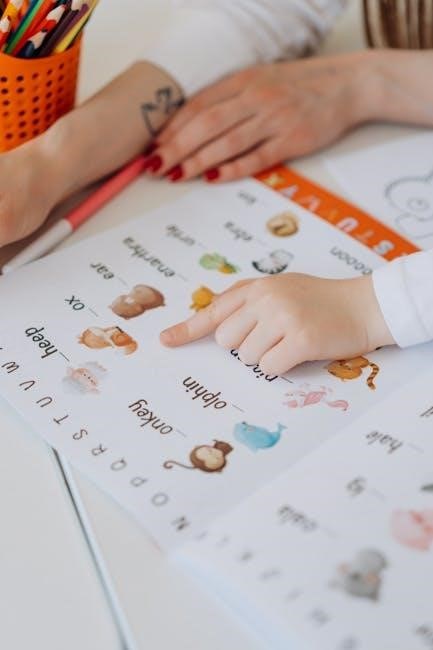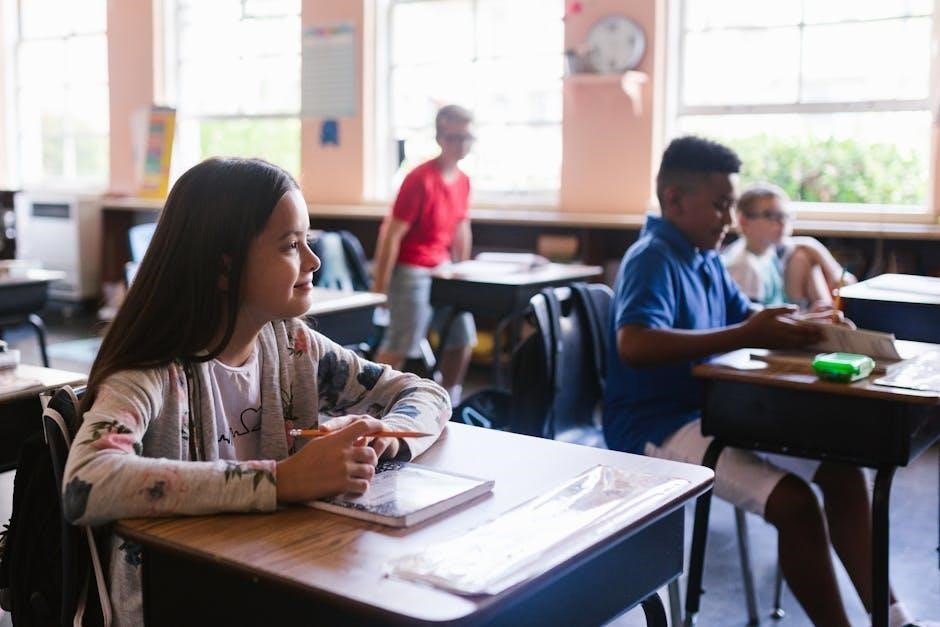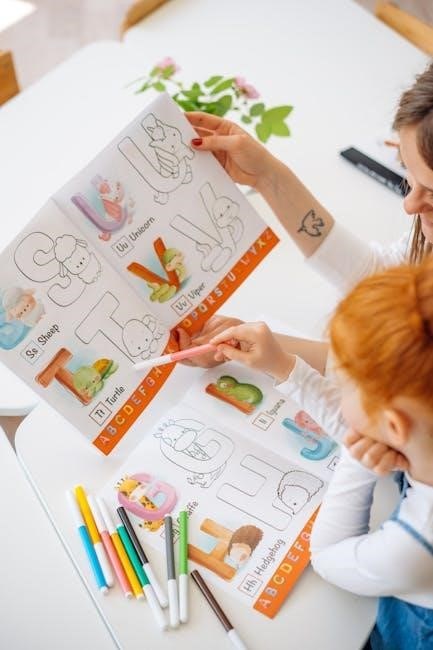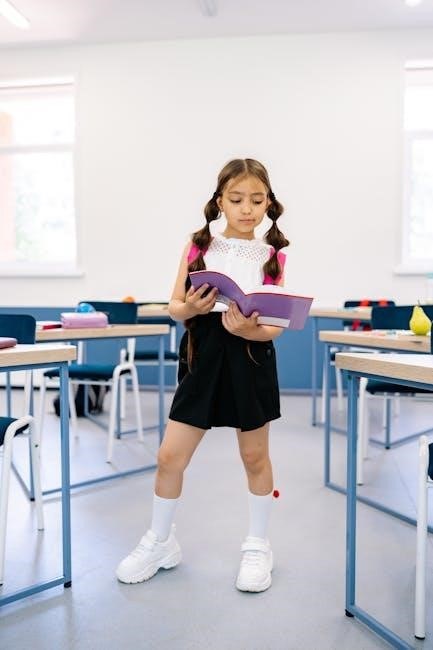
the classroom management book pdf
This book provides practical strategies and step-by-step procedures to create a safe, positive classroom environment, ensuring student learning and achievement through effective management practices;
Overview of the Book
The Classroom Management Book is a comprehensive guide offering practical strategies and step-by-step procedures to organize and structure classrooms. It provides 50 adaptable procedures to create a safe, positive learning environment. Designed for educators at all levels, the book emphasizes consistency, clear expectations, and routines. It serves as a valuable resource for establishing effective classroom management systems, ensuring student engagement and achievement. The book is a companion to other educational resources, making it a complete toolkit for successful teaching practices.
Importance of Classroom Management
Effective classroom management is essential for creating a positive and productive learning environment. It ensures student engagement, reduces disruptions, and allows teachers to focus on instruction. A well-managed classroom fosters respect, accountability, and academic success. Research shows that strong management practices significantly impact student achievement. By establishing clear expectations and consistent routines, educators can minimize behavioral issues and maximize instructional time, ensuring a supportive and structured space for all learners to thrive.

Key Concepts in Classroom Management
Classroom management involves defining clear expectations, establishing routines, and using research-based strategies to create a structured environment that supports student learning and behavior.
Definition and Scope
Classroom management refers to the process of creating and maintaining an environment that supports academic achievement and positive student behavior. It involves establishing clear expectations, procedures, and routines to ensure a structured and respectful classroom. The scope extends beyond discipline, focusing on organizing physical spaces, promoting engagement, and fostering a growth mindset. Effective classroom management is crucial for maximizing learning opportunities and minimizing disruptions, ensuring all students can thrive academically and socially.
Research-Based Strategies
Research-based strategies emphasize consistency, clear expectations, and positive reinforcement to foster a productive learning environment. These methods, backed by educational studies, focus on preventing disruptions and encouraging student engagement. Techniques such as modeling procedures, reinforcing routines, and using data-driven approaches ensure effective classroom management. By aligning practices with proven educational research, teachers can create structured, supportive spaces that promote academic success and social growth for all students, regardless of classroom dynamics or student needs.
The Role of Procedures and Routines
Procedures and routines are essential for maintaining a structured and orderly classroom environment. They provide clear expectations for student behavior, reducing disruptions and fostering a sense of predictability. By establishing consistent processes for tasks like entering the classroom, handling materials, and transitioning between activities, teachers create a framework that supports learning. These routines not only promote efficiency but also help students develop self-discipline and responsibility, ensuring a smooth and productive educational experience for all.

Practical Strategies for Effective Classroom Management
Implementing clear expectations, encouraging positive behavior, and effectively handling disruptions are key strategies. These practices promote engagement, reduce chaos, and foster a productive learning environment for all students.
Establishing Expectations
Clear expectations are the foundation of effective classroom management. Teachers should model and communicate high standards, ensuring students understand behavioral and academic goals. Consistency in enforcing these expectations helps create a structured environment. Involving students in setting rules fosters ownership and accountability. Visual reminders and positive reinforcement further support adherence to expectations, promoting a respectful and focused classroom culture. This approach ensures clarity and mutual understanding, laying the groundwork for a productive learning environment.
Encouraging Positive Behavior
Encouraging positive behavior is essential for fostering a productive classroom environment. Recognizing and rewarding good behavior reinforces desirable actions, while clear expectations guide students. Positive reinforcement, such as verbal praise or incentives, motivates students to exhibit respectful and focused behavior. Teachers can also use non-verbal cues and inclusive practices to create a supportive atmosphere. By consistently acknowledging positive actions, educators promote a culture of mutual respect and accountability, encouraging students to take ownership of their behavior and contribute to a harmonious learning space.
Handling Disruptions and Engaging Students
Handling disruptions effectively ensures a focused learning environment. Proactive strategies, such as clear communication and consistent enforcement of expectations, prevent misbehavior. Teachers can use positive reinforcement and redirection to refocus students. Engaging students through interactive activities and meaningful lessons minimizes disruptions. By addressing underlying causes of misbehavior and fostering a supportive classroom culture, educators maintain a productive and respectful atmosphere, encouraging student participation and accountability. These approaches help teachers manage challenges while promoting academic engagement and social growth. Consistency and empathy are key to resolving disruptions effectively.

The Role of the Teacher in Classroom Management
The teacher plays a crucial role in establishing expectations, maintaining order, and fostering a positive learning environment, ensuring students’ academic and social growth through effective management practices.
Teacher as a Role Model
The teacher serves as a pivotal role model, demonstrating professionalism, respect, and accountability. By modeling positive behaviors and attitudes, educators create a foundation for a disciplined and respectful classroom culture. Consistency in actions and words reinforces expectations, fostering trust and accountability among students. As a role model, the teacher inspires students to adopt similar values, promoting a growth mindset and a love for learning. This influence extends beyond academics, shaping students’ social and emotional development, as emphasized in The Classroom Management Book.
Building Student-Teacher Relationships
Building strong student-teacher relationships is essential for effective classroom management. Mutual respect, trust, and open communication foster a positive learning environment. Teachers who take the time to understand students’ backgrounds and interests create a sense of belonging. Positive interactions and personalized attention help students feel valued, enhancing their engagement and motivation. Strong relationships also encourage students to seek support when needed, promoting academic and emotional growth, as highlighted in The Classroom Management Book.
Professional Development for Teachers
Professional development is crucial for teachers to enhance their classroom management skills. The book emphasizes continuous learning and adapting strategies to meet diverse student needs. It provides updated research, practical techniques, and real-world examples to help educators refine their approaches. By investing in professional growth, teachers can create more effective learning environments, ensuring student success and personal satisfaction in their careers, as detailed in The Classroom Management Book.

Creating a Supportive Classroom Environment
A supportive classroom environment fosters safety, positivity, and inclusivity, enabling students to thrive academically and socially. Organized spaces and clear routines promote focus and reduce disruptions, ensuring a conducive learning atmosphere where all students feel valued and supported.
Organizing the Physical Space
Organizing the physical space in the classroom is crucial for creating an efficient and focused learning environment. Arranging furniture to promote movement and collaboration, while ensuring clear pathways, helps minimize distractions. Strategic placement of materials and resources ensures accessibility, reducing wasted time. Incorporating visual reminders and structured zones for different activities enhances clarity and purpose. A well-organized space not only encourages student responsibility but also supports the teacher’s ability to manage the classroom effectively, fostering a productive and calm atmosphere conducive to learning and achievement.
Promoting a Growth Mindset
Promoting a growth mindset in the classroom fosters resilience, motivation, and a love for learning. Teachers can encourage this by praising effort, discussing challenges as opportunities for growth, and normalizing mistakes as part of the learning process. Creating an environment where students feel safe to take risks and view failures as stepping stones to success helps build confidence and perseverance. This mindset not only enhances academic performance but also prepares students to embrace lifelong learning and adapt to future challenges effectively.
Addressing Diverse Learning Needs
Addressing diverse learning needs ensures all students receive tailored support, fostering inclusivity and maximizing potential. By incorporating differentiated instruction, Universal Design for Learning (UDL), and scaffolding techniques, teachers can cater to varying abilities, learning styles, and cultural backgrounds. This approach promotes equity, engagement, and academic success for all learners, ensuring no student is left behind in the educational journey.

Rules and Procedures in the Classroom
Clear rules and consistent procedures are essential for a structured classroom environment, ensuring student safety and focus. They provide a framework for positive behavior and accountability.
Developing Clear Rules
Clear rules are essential for maintaining order and ensuring student safety. They should be simple, specific, and measurable, with clear consequences for misbehavior. Involving students in the rule-making process fosters a sense of ownership and responsibility. Rules should be posted prominently and reviewed regularly. Consistency in enforcement is key to fostering a predictable and respectful classroom environment. By establishing these guidelines early, teachers create a foundation for a well-managed, focused, and productive learning space.
Teaching and Reinforcing Procedures
Teaching procedures involves modeling and demonstrating expectations clearly. Students should understand and practice routines such as entering the classroom, handling materials, and transitioning between activities. Consistency is key; reinforce procedures regularly to ensure they become habits. Positive reinforcement, like praise, encourages adherence. By teaching procedures methodically, teachers create a structured environment where students know what to expect, fostering a respectful and focused classroom culture.
Consistency in Enforcement
Consistency in enforcing classroom rules and procedures is crucial for maintaining order and respect. Teachers must apply expectations uniformly to avoid confusion and ensure fairness. When students know the consequences of their actions, they are more likely to adhere to guidelines. Consistency fosters a predictable environment, reducing disruptions and allowing for focused learning. By addressing minor issues promptly and applying consequences fairly, teachers reinforce the importance of following classroom norms, creating a culture of accountability and mutual respect.

Technology and Classroom Management
Integrating technology into classroom management enhances organization and engagement. Teachers can use digital tools to monitor progress and maintain order while fostering a focused learning environment.
Integrating Digital Tools
Integrating digital tools enhances classroom management by streamlining organization and engagement. Teachers can utilize educational software, apps, and platforms to monitor student progress, manage behavior, and facilitate communication. Digital tools such as classroom management apps help track attendance, assign tasks, and provide real-time feedback. Additionally, interactive whiteboards and online collaboration tools foster active participation and create a tech-savvy learning environment. These tools not only modernize teaching practices but also help maintain a structured and focused classroom, benefiting both instructors and students.
Managing Screen Time and Digital Behavior
Effective classroom management involves setting clear expectations for screen time and digital behavior. Teachers can establish tech-free zones, monitor app usage, and create digital citizenship guidelines. Using apps to track screen time and block distractions helps maintain focus. Encouraging responsible device use fosters a productive learning environment. Balancing technology integration with structured rules ensures students remain engaged while minimizing digital distractions, promoting a culture of accountability and respect for technology in the classroom.
Using Educational Software Effectively
Integrating educational software enhances learning and classroom management by providing interactive tools that engage students; Teachers should align software with curriculum goals, ensuring it complements instruction. Training students on proper software use and establishing clear expectations for digital interactions are key. Monitoring progress and providing feedback helps maximize effectiveness. By balancing technology with traditional teaching methods, educators can create a dynamic, student-centered environment that fosters academic success and digital literacy, making software a valuable asset in modern classrooms.

Cultural Sensitivity in Classroom Management
Cultural sensitivity is crucial for creating an inclusive classroom environment, ensuring all students feel respected and valued. Understanding and adapting to diverse backgrounds fosters positive interactions and learning.
Understanding Cultural Differences
Understanding cultural differences is essential for fostering an inclusive classroom environment. Recognizing diverse backgrounds, values, and communication styles helps teachers adapt strategies to meet all students’ needs. Cultural sensitivity involves being aware of nuances like nonverbal cues, language barriers, and varying learning styles. Teachers must also reflect on their own biases to create a respectful and equitable space. By embracing cultural diversity, educators can build stronger connections with students and enhance overall learning experiences, ensuring every student feels valued and supported.
Adapting Strategies for Diverse Classrooms
Adapting strategies for diverse classrooms involves tailoring approaches to meet the unique needs of students from varied cultural, linguistic, and educational backgrounds. Teachers must remain flexible, using differentiated instruction and culturally responsive practices. This includes incorporating diverse materials, encouraging inclusive discussions, and leveraging technology to engage all learners. By creating a culturally sensitive environment, educators ensure equitable opportunities for academic success and social growth, fostering a sense of belonging among all students.
Fostering Inclusivity and Respect
Fostering inclusivity and respect in the classroom involves creating a welcoming environment where all students feel valued and respected. Teachers can achieve this by promoting positive interactions, encouraging empathy, and addressing diverse learning needs. Inclusive practices, such as differentiated instruction and culturally responsive teaching, help ensure all students participate fully. By modeling respectful behavior and reinforcing positive values, educators cultivate a classroom culture of kindness, equity, and collaboration, empowering students to thrive academically and socially.

Assessing and Improving Classroom Management
Evaluating classroom management involves monitoring behavior, gathering feedback, and adjusting strategies to ensure a productive learning environment. Consistency and clear procedures are key to improvement.
Monitoring and Evaluating Effectiveness
Monitoring classroom management involves consistently observing student behavior and engagement to assess the effectiveness of established procedures. Teachers can use feedback from students and peers to identify strengths and areas for improvement. Regular reflection on classroom dynamics helps refine strategies, ensuring a productive and respectful learning environment. By maintaining consistency and clear expectations, educators can evaluate the impact of their management practices and make data-driven adjustments to enhance student achievement and overall classroom functionality.
Gathering Feedback from Students and Peers
Gathering feedback from students and peers is essential for refining classroom management strategies. Teachers can use surveys, focus groups, or one-on-one meetings to collect insights on what works well and what needs improvement. Peer observations and feedback from colleagues provide additional perspectives on classroom dynamics. By actively listening to student and peer feedback, educators can identify areas for growth and make informed adjustments to create a more supportive and effective learning environment for all students.
Adjusting Strategies as Needed
Classroom management strategies must be flexible and adaptable to meet the evolving needs of students and the classroom environment. Teachers should regularly assess the effectiveness of their approaches and make adjustments as needed. The book emphasizes the importance of monitoring progress and being proactive in modifying strategies to ensure a positive and productive learning environment. By staying responsive and open to change, educators can address challenges effectively and maintain a well-managed classroom that supports student success and engagement.
The Classroom Management Book offers comprehensive strategies to create a positive learning environment, ensuring student success. Its practical approaches and research-based techniques empower educators to foster productive classrooms effectively.
The Classroom Management Book provides a comprehensive guide to creating a safe and positive learning environment. It offers 50 step-by-step procedures for organizing routines, ensuring consistency, and promoting student success. The book emphasizes research-based strategies, adaptability, and preventing discipline issues. By focusing on clear expectations, respectful relationships, and effective procedures, educators can foster a productive classroom culture. Designed for teachers of all levels, it equips them with practical tools to enhance student achievement and maintain a well-managed classroom environment.
Final Thoughts on Effective Classroom Management
Effective classroom management is the cornerstone of a successful educational environment. By implementing research-based strategies, establishing clear expectations, and fostering positive relationships, educators can create a structured and supportive classroom. Consistency, adaptability, and a focus on student well-being are key to long-term success. The Classroom Management Book offers practical tools to help educators achieve these goals, ensuring a productive and engaging learning experience for all students.

Additional Resources
Explore recommended reading, online tools, and professional development opportunities to enhance your classroom management skills, including workshops and digital resources for educators.
Recommended Reading
Explore essential books like The Classroom Management Book by Harry K. Wong, offering practical strategies and step-by-step procedures for creating a structured learning environment. Other notable reads include Classroom Management That Works by Robert Marzano, which provides research-based techniques for effective teaching. These resources offer insights into organizing routines, promoting positive behavior, and fostering a growth mindset, equipping educators with tools to enhance student engagement and achievement in diverse classroom settings.
Online Tools and Communities
Utilize online platforms like RedShelf for accessing eBooks and classroom management guides. Tools such as spin wheels and roleta online can enhance engagement and decision-making in the classroom. Join communities like United Way Online and educational forums to connect with educators and share strategies. These resources provide practical insights and innovative approaches to fostering a productive learning environment, helping teachers implement effective classroom management techniques and stay updated on best practices.
Workshops and Training Opportunities
Explore workshops and training sessions, such as Zoom meetings on June 19, 2025, offering insights into classroom management. These interactive sessions provide teachers with hands-on strategies and resources to enhance their teaching skills. Workshops often include discussions on implementing effective procedures, fostering positive behavior, and adapting strategies for diverse classrooms. They serve as valuable opportunities for professional development, helping educators create structured and supportive learning environments aligned with the principles outlined in The Classroom Management Book.